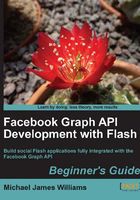
Accessing the Graph API through a Browser
We'll dive right in by taking a look at how the Graph API represents the information from a public Page.
Note
When I talk about a Page with a capital P, I don't just mean any web page within the Facebook site; I'm referring to a specific type of page, also known as a public profile. Every Facebook user has their own personal profile; you can see yours by logging in to Facebook and clicking on the "Profile" link in the navigation bar at the top of the site. Public profiles look similar, but are designed to be used by businesses, bands, products, organizations, and public figures, as a way of having a presence on Facebook.
This means that many people have both a personal profile and a public profile. For example, Mark Zuckerberg, the CEO of Facebook, has a personal profile at http://www.facebook.com/zuck and a public profile (a Page) at http://www.facebook.com/markzuckerberg. This way, he can use his personal profile to keep in touch with his friends and family, while using his public profile to connect with his fans and supporters.
There is a second type of Page: a Community Page. Again, these look very similar to personal profiles; the difference is that these are based on topics, experience, and causes, rather than entities. Also, they automatically retrieve information about the topic from Wikipedia, where relevant, and contain a live feed of wall posts talking about the topic.
All this can feel a little confusing - don't worry about it! Once you start using it, it all makes sense.